Lake of the Woods is a massive lake that spreads across the Canadian–United States border, touching the provinces of Ontario, Manitoba, and the US state of Minnesota. This lake covers an area of 1,727 square miles, with a length of approximately 70 miles and a maximum width of 60 miles.
Fishing lovers are drawn to the unspoiled waters of Lake of the Woods, where a diverse array of fish species awaits. Curious about what you might reel in during your visit? Fret not! In this article, we will explore the many types of fish that call these waters home and are ready for you to catch them[. Let’s dive in!
Types of Fish You Might Catch in Lake of the Woods
Let’s get straight to the fish waiting for you to cast your lines in Lake of the Woods!
1. Walleye
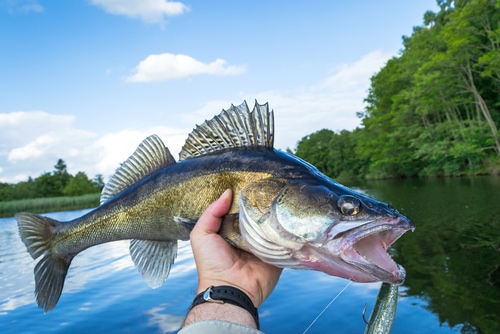
One of the most common fish species in Lake of the Woods is walleye.
©Piotr Wawrzyniuk/Shutterstock.com
Walleye are a highly sought-after species found in great numbers in Lake of the Woods and can be fished throughout the year. As a type of perciform fish, walleye resemble perch, though walleye are much larger. A noticeable feature of the walleye is its dorsal fin, which is situated on the top or back of the fish and split into two segments. The fish displays a dark green hue on its back, complemented by golden yellow sides and a white underside.
Walleye range in size from around 2.5 to 3 feet in length.
This species feeds exclusively on other animals, having a strictly carnivorous diet.
Catching walleye is easy, with many methods available. Anglers often use various techniques, such as trolling with live bait, using hard plastic lures, employing a jig-and-minnow, or even fishing with a simple bobber.
2. Yellow Perch
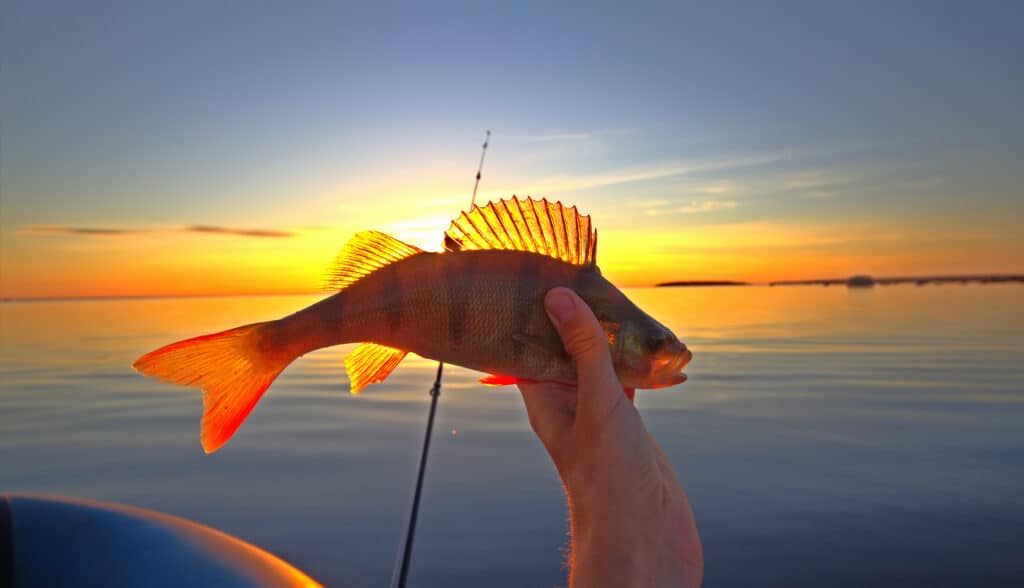
While similar to walleye, the yellow perch is a much smaller fish.
©Maximilliam cabinet/Shutterstock.com
Yellow perch are usually gold or yellow in color, adorned with 6 to 8 unique olive-green triangular stripes on their sides. While their normal size is about 7.5 inches, they have been known to grow as long as 19.7 inches!
A yellow perch’s daily diet consists of other smaller fish and fish eggs.
When fishing for yellow perch, it’s best to use thin, delicate hooks or jigs, along with bait and a small bobber that’s sensitive to even the gentlest nibble. A year-round favorite among anglers, yellow perch remains active in all seasons.
3. White Sucker
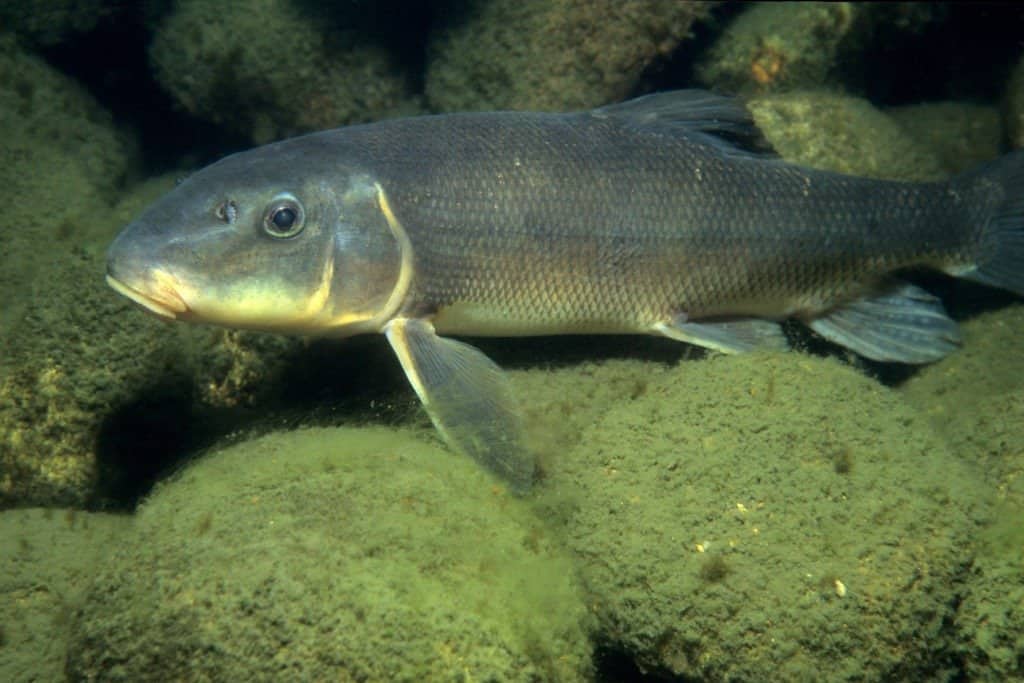
Another common fish found in Lake of the Woods is the white sucker.
©RLS Photo/Shutterstock.com
The white sucker’s mouth is round and surrounded by thick lips. Its body is sleek, with a single, flat dorsal fin on top and a notched tail fin. The upper part of the white sucker is typically olive in color, while the underside has a distinctive cream hue. The color tends to become darker when the fish is spawning.
These fish generally measure between 12 to 20 inches in length. Their diet is diverse, encompassing aquatic insect larvae, water fleas, clams, algae, various other plant materials, and fish eggs.
When it comes to catching white suckers, there are several effective methods to choose from, including casting with bait, using a bottom bouncer, cast and retrieve fishing technique, chumming, drift fishing, fly fishing, and trolling in fresh water.
4. Smallmouth Bass
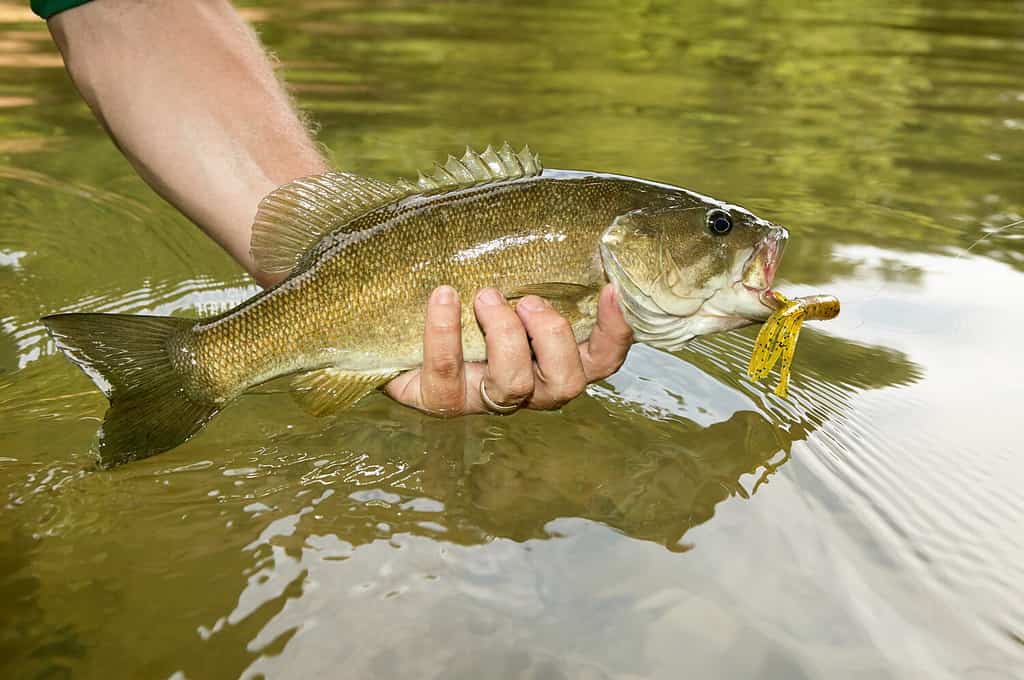
Smallmouth bass are relatively easy to catch and taste great!
©CLP Media/Shutterstock.com
Another common fish in Lake of the Woods is the smallmouth bass. Adults of this species can reach a length of up to 26 inches, although they typically fall within the 8 to 22-inch range. With a slender body, smallmouth bass displays a pale brown or olive green color on top, contrasted by a yellow-white belly.
Their diet is diverse and includes crayfish, frogs, minnows, shad, smaller fish, and tadpoles.
Anglers have a variety of options for catching smallmouth bass. Common methods involve casting with hard plastic baits, spinners, or jigs, or using plastic imitations of worms or crayfish. Casting or trolling with a hard plastic lure is one of the most favored techniques for catching smallmouth bass.
5. Sauger
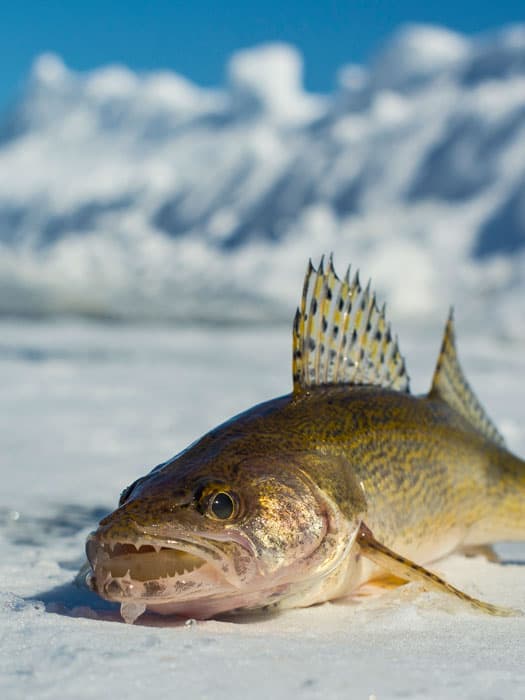
This terrifying-looking fish is a sauger. They are carnivorous and grow to over 1 foot!
©Steve Oehlenschlager/Shutterstock.com
Sauger, found in Lake of the Woods, have a golden olive hue on their backs, silver-yellow sides, and a white belly. Belonging to the perch family, they feature a large spiny dorsal fin, with the added unique detail of noticeable rows of spots on those fins.
Adult sauger typically ranges in size from 12 to 15 inches. Their diet consists primarily of smaller fish, crayfish, other types of crustaceans, and insects.
Catching sauger isn’t overly complicated. A popular method involves vertically jigging with a weighty jig that ranges from ¾ to 1 ounce, sometimes even larger. This jig could be made of soft plastic, hair, or feathers. Many anglers choose to add a minnow to the jig, enhancing the lure’s appeal with both scent and flavor, making it easier for the fish to find it in unclear waters.
6. Rainbow Trout
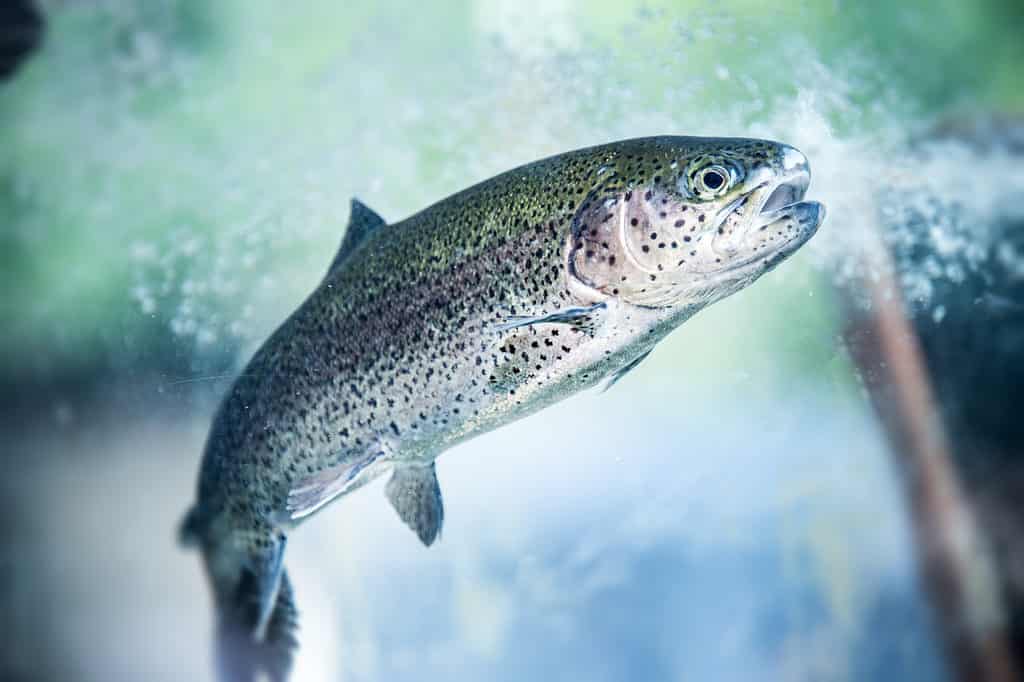
A difficult-to-catch fish in Lake of the Woods is the rainbow trout. Your best bet is using fly-fishing methods.
©iStock.com/Max2611
Rainbow trout are a delicious freshwater species recognized by their narrow, extended body, highlighted by a shimmering pink or red stripe running along their sides. Their coloring is generally silver on the sides, sometimes with a touch of green, and they have a dark blue to olive back and a white belly.
These fish typically measure between 20 to 30 inches in length. The diet of rainbow trout mainly consists of larvae, insects, and other fish.
Fly fishing is the most popular and effective method for catching rainbow trout, but you can certainly use other methods, such as bait casting, spin casting, and upstream casting.
7. Northern Pike

A huge fish that can be caught in Lake of the Woods is the northern pike, which can grow to nearly 2 feet in length!
©Rostislav Stefanek/Shutterstock.com
Northern pike are one of the most difficult fish species to catch, making them highly sought after by sport fishermen. You can identify northern pike by their long, slender body, sharp teeth that tilt backward, duck-like mouths, and elongated, flat heads. The coloring of their back and sides ranges from dark green to olive-green, accented with yellow to white spots.
These fish usually measure from 18 to 20 inches in length. Their primary diet is other fish, including other pike.
Adult northern pike has a preference for eating perch and suckers that are between 4 to 15 inches long. Therefore, using baits that resemble these species can be effective. Since northern pike tend to approach their prey from below, lures that act like injured or dying fish, such as jerk bait lures, can also be a good choice when fishing for them in Lake of the Woods.
8. Muskellunge
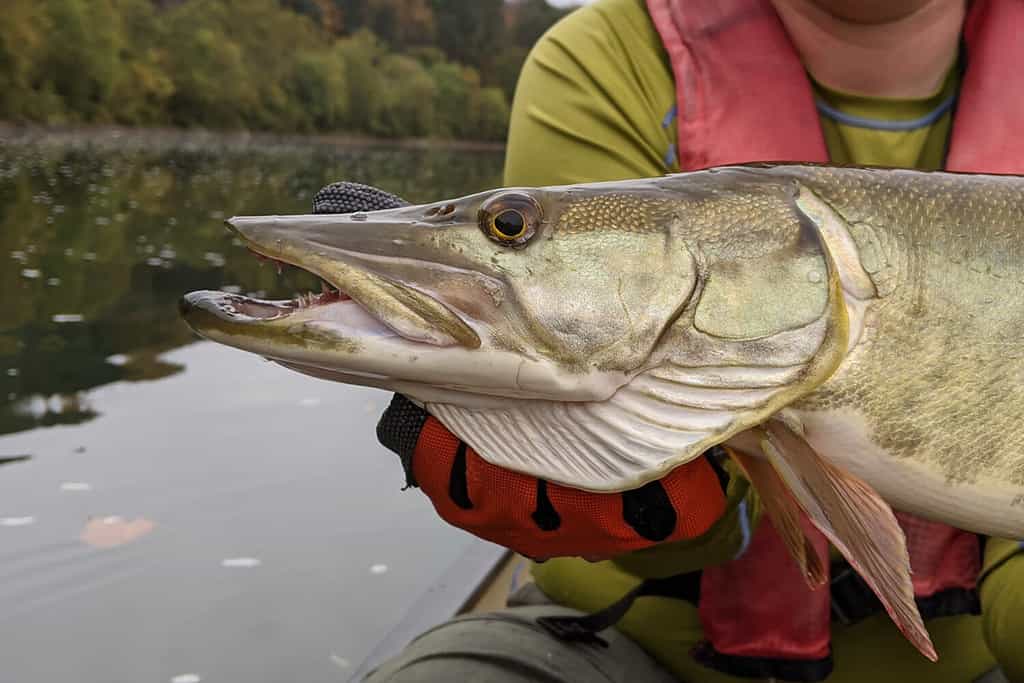
One of the largest freshwater fish in North America is the Muskie! This fish even eats muskrats and ducklings!
©M Huston/Shutterstock.com
Muskellunge can grow to impressive size and have a strikingly identifiable appearance. You can recognize them by their dark green back, light greenish-yellow belly, and cream-colored vertical stripes along the sides.
These fish often reach lengths of 30 to 36 inches! Their diet is varied, including fish, insects, and even ducklings, frogs, muskrats, and mice.
Anglers commonly catch muskellunge by casting large artificial lures, usually ranging from five to 10 inches in length or even more. This is often done from a slowly drifting or motoring boat, allowing the fisherman to traverse a large area of water in a relatively short amount of time.
9. Largemouth Bass
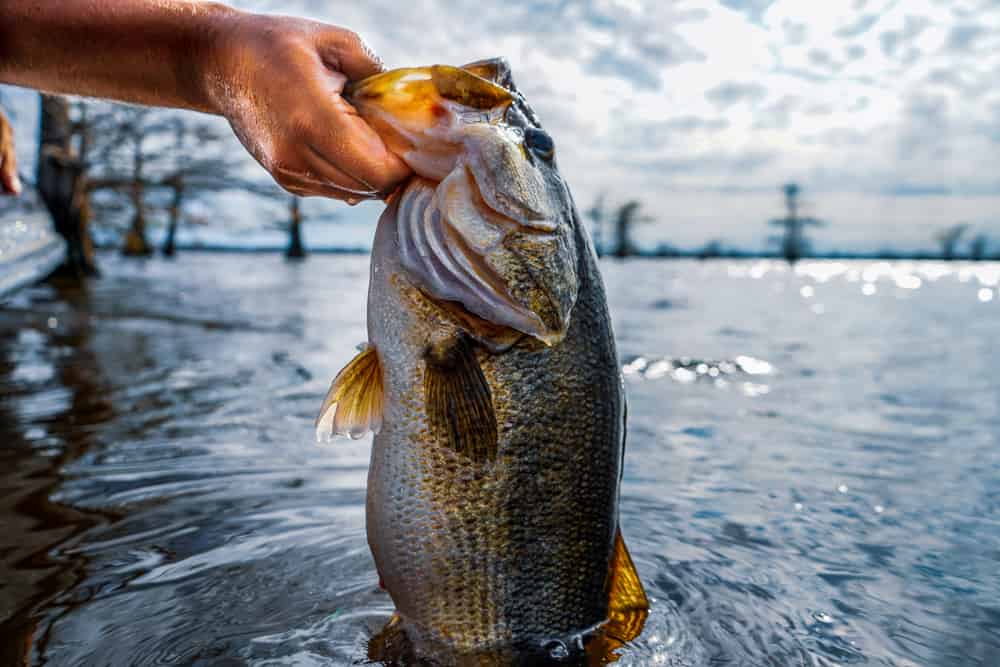
The best way to distinguish largemouth from smallmouth bass is that largemouth bass jaws extend above their eye.
©Maclane Parker/Shutterstock.com
Largemouth bass have dark olive green backs, light green sides that fade to a white belly, and a dark blotchy band running along their sides. The most distinguishing feature of this species is that the upper part of its mouth reaches beyond the eye, unlike the smallmouth bass, where the upper jaw stops below the eye.
These fish typically measure around 16 inches in length. Adult largemouth bass have a varied diet that includes insects, fish, and crayfish, often favoring sunfish as prey.
Catching largemouth bass can be done in various ways. Some anglers may use a worm or minnow to lure them in. However, the majority of largemouth bass are caught using an array of artificial lures such as soft plastic jigs, plastic worms, tube jigs, surface lures, spinners, swim baits, or small spoons.
10. Lake Whitefish
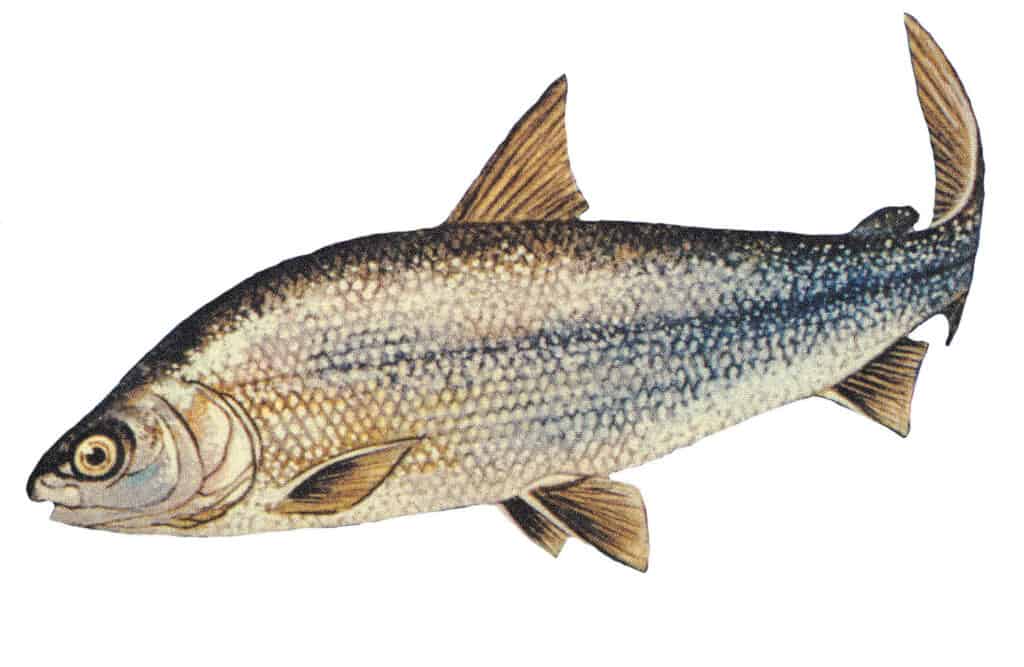
Another fish species that you may encounter in Lake of the Woods is lake whitefish.
©NOAA Great Lakes Environmental Research Laboratory / flickr – License
Lake whitefish display an olive-green to blue hue on their back, complemented by silvery sides. Their physical characteristics include a small mouth positioned under a rounded snout and a tail that is deeply forked.
These fish can grow as long as 31 inches, though they commonly only reach around 20 inches. Lake whitefish primarily consume zooplankton, midge larvae, and tiny crustaceans, but as they grow, they may also feed on small smelts and other fish.
Anglers can pursue lake whitefish using traditional hook-and-line methods or fly fishing. Fly fishing is especially effective during the spring and winter seasons. In the fall and early winter, they are more active during daylight hours. Floating a small jig near the surface under a float is another proven method to catch these fish.
11. Lake Trout
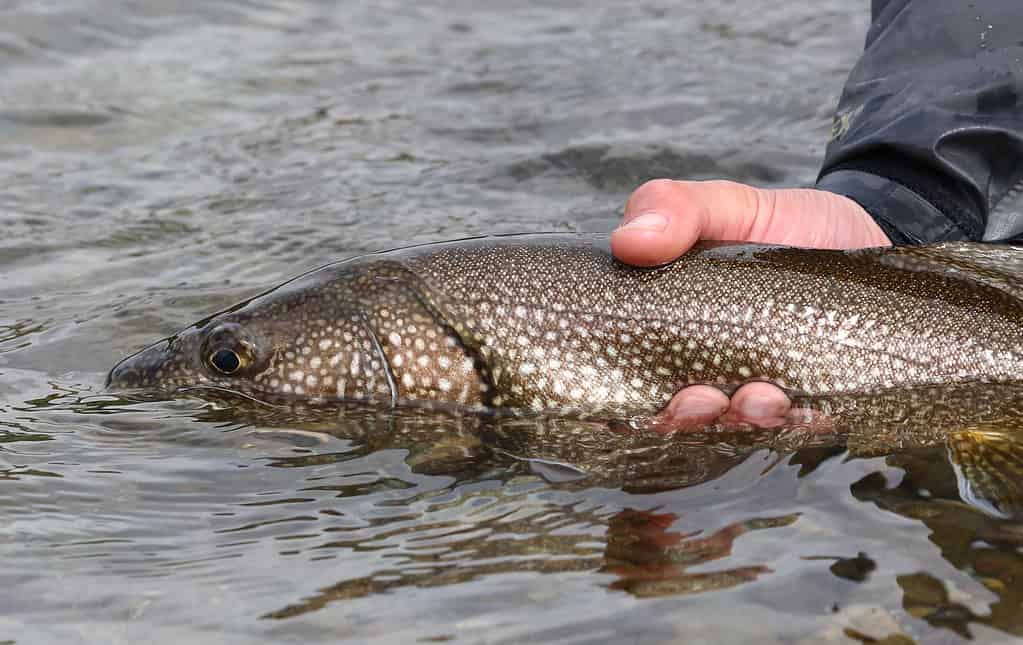
Not nearly as beautiful as rainbow trout but just as tasty, lake trout are a delicious fish to catch.
©Iryna Harry/Shutterstock.com
Lake trout, another fish found in Lake of the Woods, are the least vibrant among the trout species. Their appearance is mostly grey, punctuated by irregular white spots. During their fall mating season, the fins close to the tail take on a soft orange hue.
Typically, lake trout will grow to between 18 and 24 inches in length. While the young primarily consume plankton, insects, and tiny invertebrates, the adults are more inclined to eat fish.
When fishing for lake trout, there are various methods to employ. You can use medium-weight spinning gear for bottom-fishing with dead ciscos or float live minnows beneath a float. Troll fishing with spinners that are tipped with minnows is also effective.
12. Lake Sturgeon
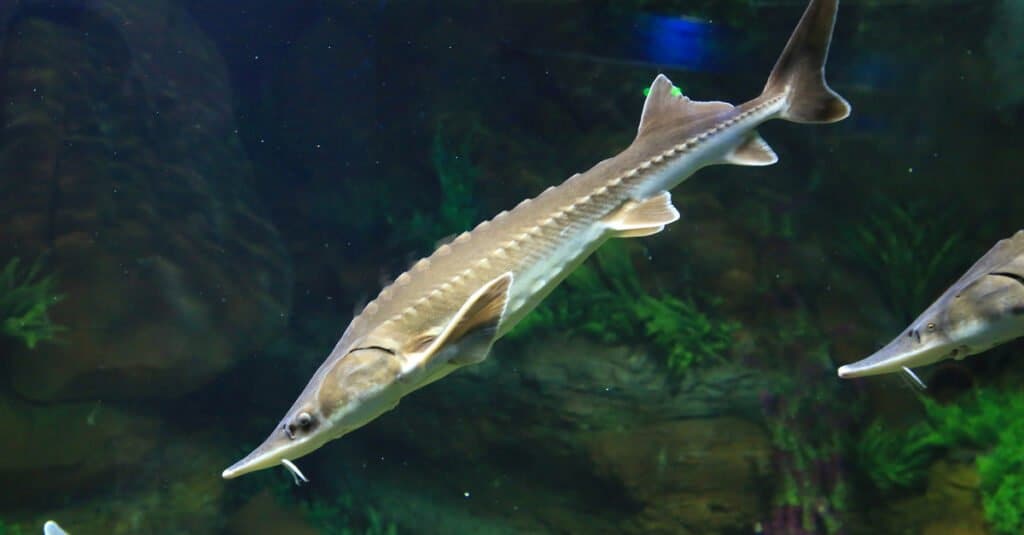
Also known as the
rockfish
, the lake sturgeon looks almost like an underwater dinosaur.
©Geermy/Shutterstock.com
The lake sturgeon, with its unique, primitive look, has a torpedo-like body adorned with five lines of bony plates. These are found on the top and on both sides of its body. The sturgeon’s sharp, cone-shaped snout hosts four smooth whisker-like barbels, and its mouth is noticeably large, featuring two smooth sections on the lower lip. Lake sturgeon are one of the largest freshwater fish species, and you may be lucky enough to catch one of these fish in Lake of the Woods.
These fish can reach impressive lengths of up to six and a half feet. Imagine catching a fish that is bigger than you! Their diet consists of various water-based macroinvertebrates, such as freshwater mussels, snails, small crustaceans, and even small fish.
Catching a sturgeon is difficult but not impossible. The best method involves dropping live bait to the bottom of the water and patiently waiting for a bite. A common fishing setup for sturgeon includes a strong muskellunge rod and a level-wind reel that’s loaded with an 80- to 100-pound test braided line.
13. Golden Redhorse

These fish are another popular fish species you can catch in Lake of the Woods.
©M Huston/Shutterstock.com
The golden redhorse is a somewhat plump fish with coarse scales, bearing a shade ranging from light yellow to bronze. Unlike the silver redhorse, it has no dark spots at the base of its scales, and the outer edge of its dorsal fin is slightly curved inward with typically 12 to 13 rays.
Adults of this species usually measure between 12 and 20 inches. Their diet is diverse and includes various small aquatic organisms.
Fishing for the golden redhorse is most fruitful in early spring when water temperatures approach 42°F. Anglers often find success using worms as bait, positioning them just a few inches above the stream’s bottom. The most common way to catch this fish is with a hook and line, although gigging is another effective method.
14. Cisco
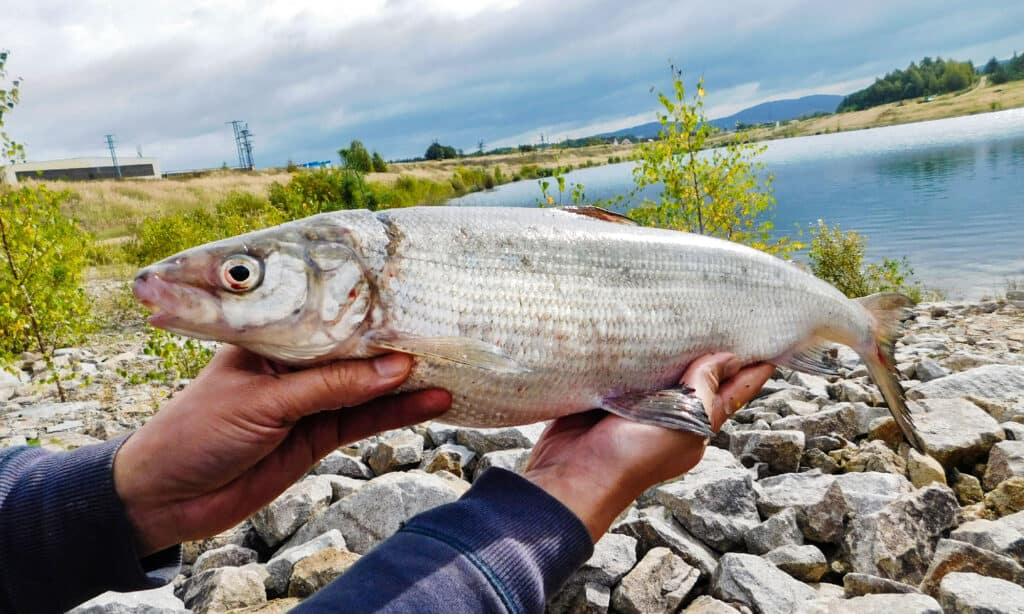
A relatively small fish that you can catch in Lake of the Woods is the cisco.
©Michaela Holubova/Shutterstock.com
The cisco is recognized by its long, slender shape and forked tail. Its upper body shows a grayish tint, the middle portion is silver, and the belly is white. A unique gray line extends horizontally from the head’s base to the tail fin, and all of its fins appear translucent.
Typically measuring between 10 and 14 inches, it primarily feeds on zooplankton and the larvae of insects.
Catching cisco doesn’t require any specialized equipment. For ice fishing, you simply need an auger to drill a hole and an ice scoop along with your standard lightweight fishing gear, including a spinning reel and a small hook. As for bait, small jigs or spoons will suffice to lure this fish.
15. Channel Catfish
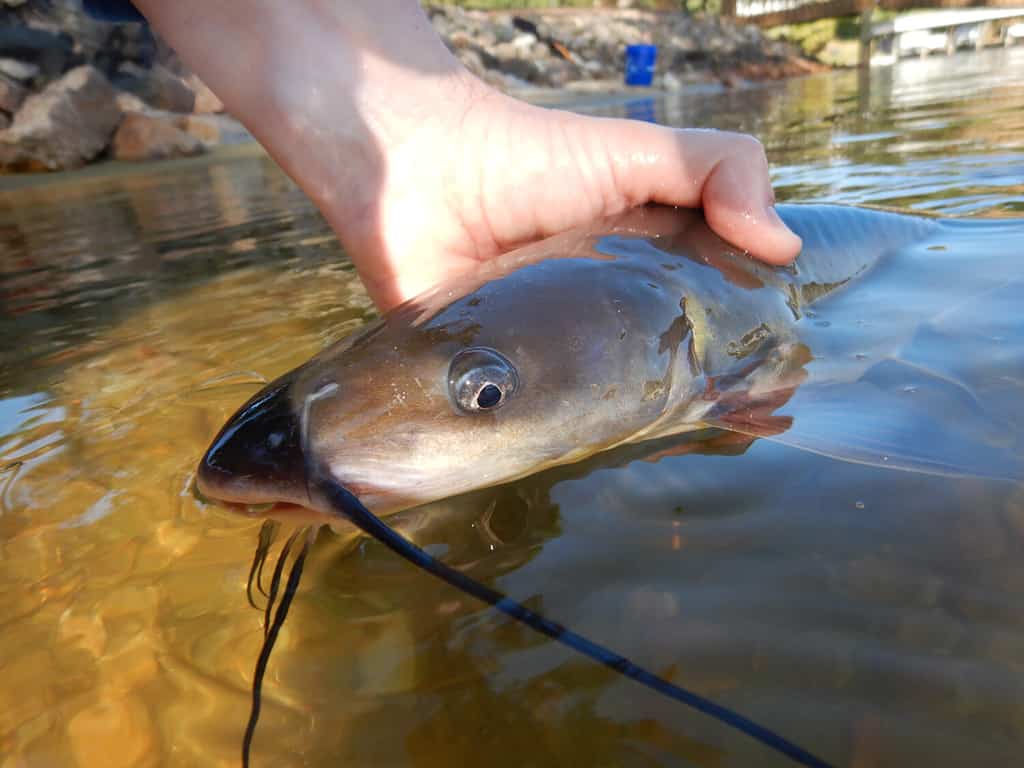
A common bottom feeder that can be a challenge to reel in is channel
catfish
.
©Brookieland/Shutterstock.com
Channel catfish are a common fish species in Lake of the Woods and measure between 15 and 24 inches in length. These fish have a gray to olive coloration with lighter undersides and feature eight distinct ‘whiskers,’ or sensory barbels, around their mouths.
As bottom-feeders, they do not discriminate what they eat. Their diet consists of everything from insects, mollusks, crustaceans, and snails to snakes and other smaller fish.
Catching a channel catfish can be a unique challenge, as they’re known to abandon bait at the slightest resistance. Sharp hooks, particularly those with bait holders on the shank, are recommended for successful fishing. If you’re using soft, prepared cheese baits, sponges, or plastic worms can be effective in enticing these intriguing fish in Lake of the Woods.
16. Burbot

This fish is a popular catch in the winter when the lake freezes over.
©Rostislav Stefanek/Shutterstock.com
Burbot have mottled skin, with colors ranging from black and grey to olive and yellow. Their unique appearance includes elongated dorsal and anal fins that stretch to a rounded tail fin, and they feature a single soft barb on their lower jaw.
Typically measuring around 28 inches, burbot primarily feed on other fish, including small yellow perch and even walleye.
Fishing for burbot can be an exciting experience, as they are drawn to a diverse range of bait, such as frozen smelt, chicken livers, or even bacon. Circle hooks are often recommended for setlines, as they minimize the risk of deeply hooking the fish. Winter, especially the ice-fishing season, is a popular time to catch burbot, as they gather in shallower water to spawn, increasing the chances of a successful catch.
17. Brown Bullhead
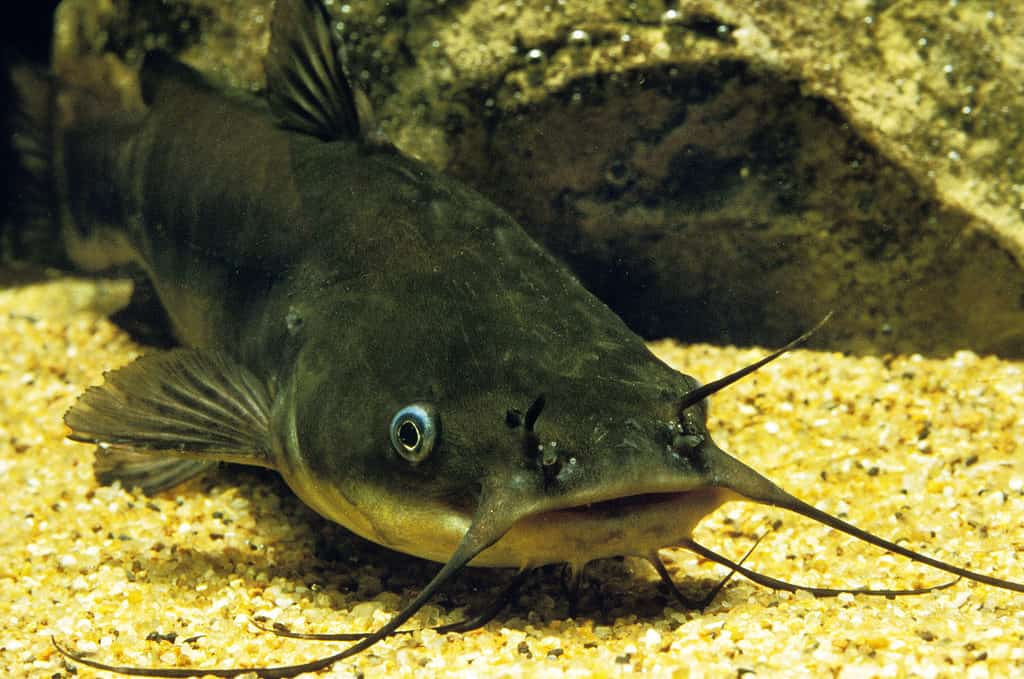
Despite being smaller than other catfish, bullheads are relatively difficult to catch!
©Slowmotiongli/Shutterstock.com
The brown bullhead is a unique type of catfish that you can find in Lake of the Woods. You can distinguish bullhead by their wide, flat head and dark facial whiskers known as barbels. Its unique spotted sides and square-shaped tail set it apart from other catfish.
Growing to just around a foot in length, the brown bullhead feeds at the bottom of the water, scavenging for algae, insects, mollusks, crustaceans, crayfish, and other fish.
The most effective way to catch brown bullhead is through bait casting or still fishing, utilizing a hook and worm as bait. When fishing for brown bullheads, traditional baits like angle worms and nightcrawlers work well, but these fish also consume almost anything they can manage.
18. Black Crappie

Crappie are a tasty fish that are relatively easy to catch in Lake of the Woods.
©Brandon Stinnett/Shutterstock.com
The black crappie has a silver appearance adorned with randomly scattered specks and spots rather than vertical stripes.
These fish typically reach a length of around 10.8 inches, and their diet consists mainly of small crustaceans and free-swimming nocturnal larvae.
When fishing for crappie, using a float is helpful, as these fish don’t always remain near the lake bottom. They can be lured with various types of bait, including small jigs, minnows, and worms. Crappies often gather near dense underwater vegetation and structures like stumps or logs, so those are great places to target them.
19. Atlantic Salmon
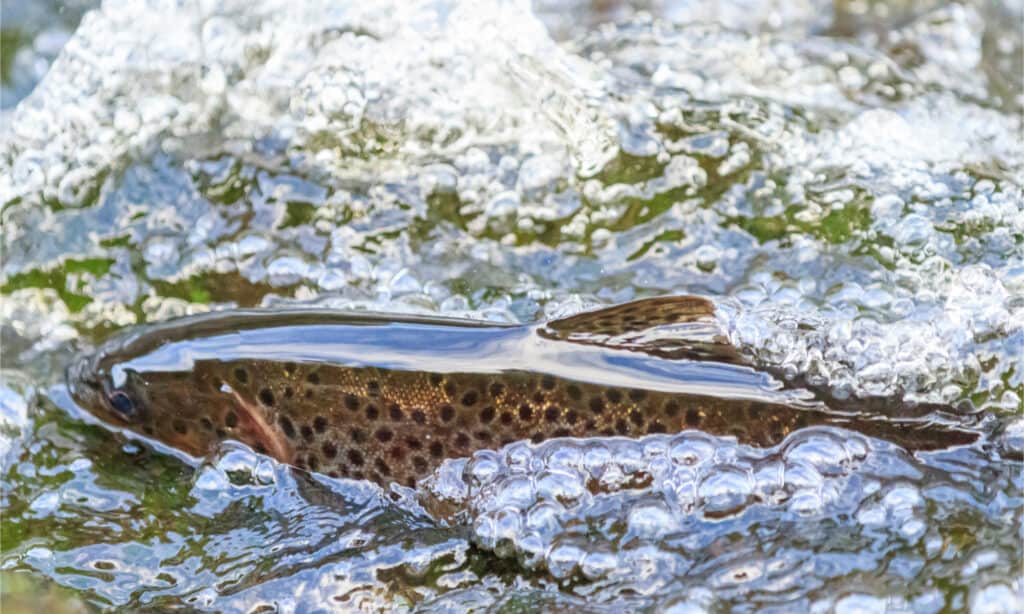
One of the most sought-after fish in Lake of the Woods (though they are very controlled) is salmon.
©Chanonry/Shutterstock.com
Atlantic salmon possess a slender body with a small head and blunt snout, and their mouths reach back just below the eyes. These fish have a silver coloring, almost white undersides, and unique dark blue-green spots arranged in a cross-like pattern.
Typically, these fish measure between 28 and 30 inches. Adult salmon mainly prefer to eat a small fish known as capelin.
You can find landlocked salmon in areas where a river flows at a pace akin to a brisk walk, particularly in extensive, sluggish runs. You can also try casting your line at the tail ends of slow pools, just before the water picks up speed. These are areas where salmon linger, waiting to seize baitfish as they move upstream.
Fishing in Lake of the Woods: Rules and Limitations
In the Minnesota section of Lake of the Woods, there are specific fishing regulations that are different from the standard rules across the state. It’s essential to become acquainted with these unique guidelines to avoid accidental infractions.
For walleye and sauger in Lake of the Woods:
- You can catch a total of six walleye and sauger combined, but no more than four of those can be Walleye.
- Walleye that are between 19.5 and 28 inches cannot be kept. You must release them right away.
- You’re allowed to keep only one walleye that’s over 28 inches in length.
Regarding Northern Pike:
- If you catch a northern pike between 30 and 40 inches, you must release it immediately.
- You can keep only one northern pike that’s over 40 inches, and the total possession limit is three.
- Note that there is no off-season for fishing northern pike in Lake of the Woods or the Rainy River.
For Yellow Perch:
- You are allowed to catch up to 20 yellow perch per day, with a maximum of 40 in your possession at any time.
- Yellow perch fishing is open year-round; there’s no closed season for this fish.
Summary of Fish You Might Catch in Lake of the Woods
| Fish | Habitat |
|---|---|
| Walleye | Deep and cool waters |
| Yellow Perch | Plant-filled shallow areas of lakes |
| White Sucker | Shallow water |
| Smallmouth Bass | Deep and shallow waters |
| Sauger | Shallow water |
| Rainbow Trout | Shaded areas with natural cover and vegetation |
| Northern Pike | Around rocky points, weed beds, and other structure |
| Muskellunge | Near weed beds, rocks, and shady areas |
| Largemouth Bass | Clear & quiet water over sand or mud |
| Lake Whitefish | Deep to shallow waters |
| Lake Trout | Shoals, shallow reefs, and rocky points |
| Lake Sturgeon | Mouth of the Rainy River |
| Golden Redhorse | Muddy or rocky bottoms |
| Cisco | Deep and shallow waters |
| Channel Catfish | Moderate to shallow depths |
| Burbot | Near rocky points and the main lake structure |
| Brown Bullhead | Mud and gravel bottoms |
| Black Crappie | Near submerged vegetation |
| Atlantic Salmon | Constantly moving between the lake |
The photo featured at the top of this post is © Kevin Wells Photography/Shutterstock.com
Thank you for reading! Have some feedback for us? Contact the AZ Animals editorial team.






